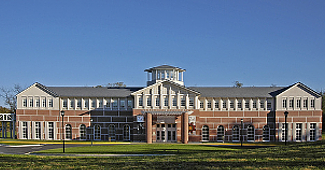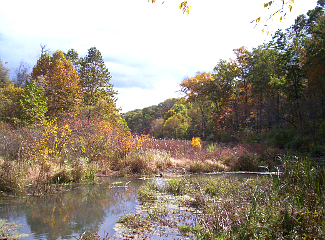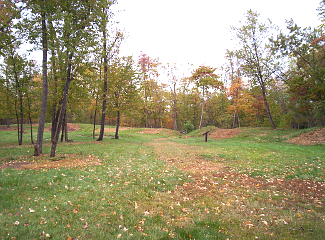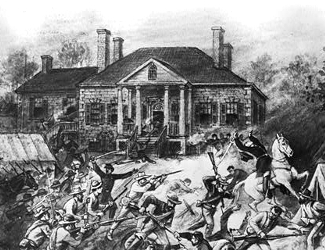
General Phil Sheridan's headquarters in downtown Winchester during the 1864 Shenandoah Valley campaign. Starting point for Rienzi's ride to rally the troops at Cedar Creek on October 19, 1864.

Winchester, Virginia
More than six battles waged war through and around Winchester during the four years of Civil War with the town changing hands seventy-two times, although prior to fifteen to twenty years ago, the town seemed to forget most of that history. But boy, they're starting to make up for lost time. Yes, there was always history represented here in a vibrant and quaint downtown replete with period buildings dating far prior to that war. There's George Washington's office from the French and Indian War in 1755 and 1756 as well as a Museum of the Shenandoah Valley to tell a broader tale. And now, with the continuing interpretation of the 3rd Winchester battle and newly opened Visitor Center, and the volunteers saving and interpreting the two Battles of Kernstown site, the amnesia of 1861 to 1865 is beginning to fade fast.
Click here to Sponsor the page and how to reserve your ad.

Winchester Then
George Washington and Winchester - Washington would begin his military and professional career in Winchester, surveying the area and overseeing the construction of Fort Loudoun, north Winchester, from 1755-8 and headquartered at the fort for two years once constructed. He was a colonel in the British militia at the time. While the fort does not remain today, the office he used at the Adams Kurtz house within the town of Winchester does.
First Kernstown - March 23, 1862. Stonewall Jackson suffers his only tactical defeat of his career while facing a Federal force over twice his size.
First Winchester - May 25, 1862. During the Shenandoah Valley campaign, Stonewall Jackson won a victory at Winchester, taking the right flank of the Union Army under General Banks and pushing it across the Potomac. Jackson's troops were outnumbered during the Shenandoah Valley campaign 18,000 to 60,000, but had a 16,000 to 6,500 man advantage during this fight.
Second Winchester - Only four days after the cavalry battle at Brandy Station, Richard S. Ewell, now commanding Jackson's corps after his death, was assigned the task of clearing the Union from the valley. He took over the Union garrison at Winchester as he moved toward Gettysburg on June 13-15, 1863.
Rutherford's Farm - Smaller battle north of Winchester just prior to Second Kernstown on July 20, 1864 with Confederate General Jubal Early's force under Ramseur defeated by General Averill. Battlefield unfortunately lost to development.
Second Kernstown - Fought four days later on July 24, 1864, unfortunate maneuver off Pritchard Hill leaves Federals exposed on three sides, forcing a fight in retreat, in what some note as the easiest victory the South ever had.
Third Winchester - Confederate General Early had been repulsed in his quest to take Washington and siphon enough troops away from Grant's siege line around Richmond and Petersburg to assist Lee in any great measure, but was still creating havoc within the Shenandoah Valley. When he met with Phil Sheridan's Valley Campaign at Winchester on September 19, 1864, the Union victory would become the penultimate win in rousting the Confederates from the valley, sealed one month later at the Battle of Cedar Creek.
Photo above: Chromolithograph of Phil Sheridan's final charge at Third Winchester, 1888, Thure de Thulstrop for L. Prang and Company. Courtesy Wikepedia Commons. Center: Battle fence at the battlefield of Third Winchester. Bottom: Pritchard House on the Kernstown Battlefield.
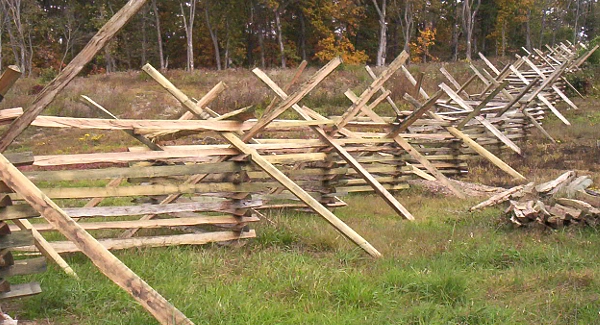
Winchester Now
Winchester was such an important point of emphasis during the Civil War, that it changed hands seventy-two times in the four years, including the three major battles of Winchester, May 25, 1862, June 13-15, 1863, and September 19, 1864, and the two major battles of Kernstown. But as we noted above, the interpretation of these sites (most of the area of the first two Winchester battles, as well as the lesser known Battle of Rutherford's Farm, have been lost to suburban sprawl) didn't really begin to take off in a coordinated way until Congress, in 1996, designated the eight counties in the Shenandoah Valley as a National Heritage area called the Shenandoah Valley Battlefields National Historic District, which ranges from Winchester in the north down I-81 to Staunton.
In September of 2015, the Battlefield of Third Winchester, sometimes called Opequan, took a large leap forward, as a Visitor Center was opened across the street from the main battlefield land, and additional trails and wayside exhibits were added to the five miles of interpretation. There's more in the works on the exhibit side, with plans to move the exhibit center into the large red barn on site, with a plaza and more coordination. But all this takes time, and money. So don't expect Gettysburg here. This is history, and important history, taking shape right before your eyes, even though it's more than one hundred and fifty years later.
There's more to see of Third Winchester, or even the first two battles, than just that preserved battlefield land. Shenandoah at War has three good brochures for driving tours of the three battles that take you to sites around and inside the town, including Star Fort and Fort Collier. Those can get a little confusing, at least until you get inside the pedestrian mall downtown. That's just plain charming.
Walking tours, museums, and driving tours take you around a historic city at the head of the Shenandoah Valley. Take in the Museum of the Shenandoah Valley, the office of George Washington, the headquarters of Stonewall Jackson and Phil Sheridan, and a pedestrian mall downtown with shopping and lots of historic buildings.
Third Winchester Battlefield - A new visitor center and five mile interpretive walk now allows for visitors to experience the land around Redbud Run as Sheridan's army pushed the Confederates toward town. Wayside exhibits and an artillery park tell the tale. Path runs interior to the site with no vehicle stopping points between the main parking area along Redbud Road and the far end wayside exhibit at the high school parking lot.
Kernstown Battlefield - Located south of town off I-81 and Route 11, three hundred and eighty-eight acres have been preserved, along with the 1854 Pritchard House, that tell the story of the March 23, 1862 First Battle of Kernstown during Stonewall Jackson's Valley Campaign and the July 24, 1864 Second Battle of Kernstown during Confederate General Jubal Early's campaign in the Shenandoah Valley. For more info on the Kernstown battles, visit our Spotlight on Lesser Known History - Civil War Kernstown. article.

T-Shirts and Souvenirs

Winchester T-Shirts and Souvenirs from the official merchandise of America's Best History. Great for the Civil War and Shenandoah history fan.
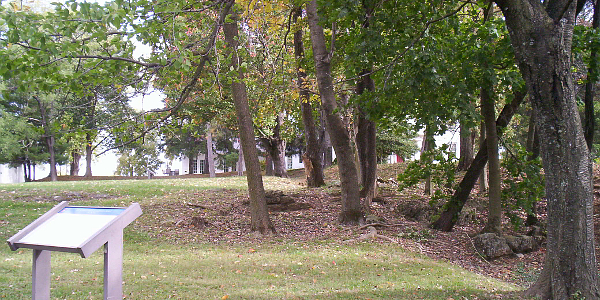
Winchester
Things You Should Not Miss
1. Take the Third Winchester battle walk amongst the cows. Surrounding the paths that circumvent the 573 acre site are farm fields filled with cows, and in the fall of 2015, some of the new paths (not open then) took you amongst them. That's not suggested; ourselves and a family of four with a dog, took a wrong turn. Starting this winter, those paths will be fenced in, so your mistake won't have consequences such as fence climbing and wondering whether a bull might strike. Either way, this five mile trek will take you over the breadth of the field, including Redbud Run and a footbridge with lots of photo opportunities.
2. Find Star Fort and Fort Collier. That's not exactly easy. They're part of the Shenandoah at War driving tours and it's easy to take a wrong turn. But while they're small earthen forts amidst some bustle (Star Fort should have been protected better), they show just what types of earth forts ringed this town for four years and where the men who fought took shelter. At Fort Collier, the original house burned down, but they built the new one amidst the earthen trenches. Interesting. Warning. You can't go inside the house, it's still occupied.
3. Saunter down the pedestrian mall downtown. Along the way, you can visit the museums around the town, including the Old Court House Museum within the mall. Just outside the mall, one block over, visit Sheridan's Headquarters. It's a store now, but also the location where Sheridan left on his Rienzi ride to rally the troops at Cedar Creek, one month after Third Winchester, and likely saved Abraham Lincoln's election victory in 1864.
4. Visit the Kernstown Battlefield and take the guided tour. Kernstown is only open from Spring to Fall on the weekends. It is staffed by volunteers, who provide tours twice on Saturdays. You might even get to ride up Pritchard Hill in a golf cart.
Photo above: Earthen trenches at Fort Collier.

Get Baseball History and Books at Stat Geek Baseball, including Baseball's Best 150.

